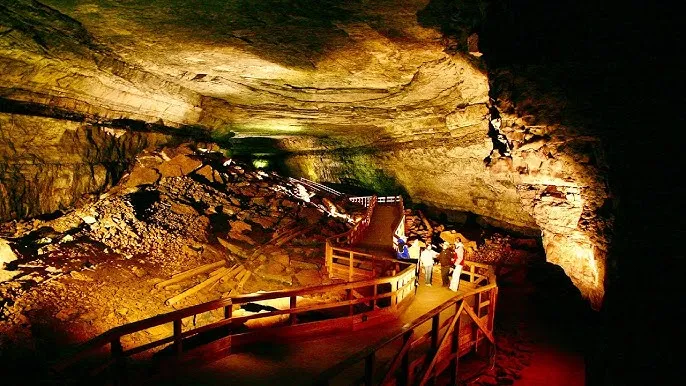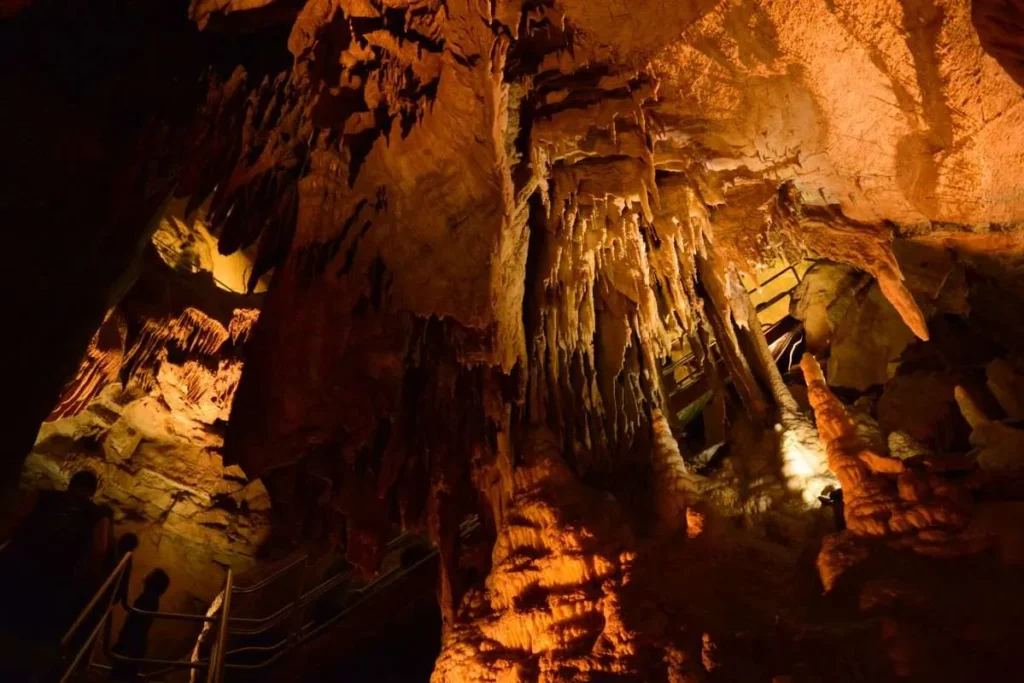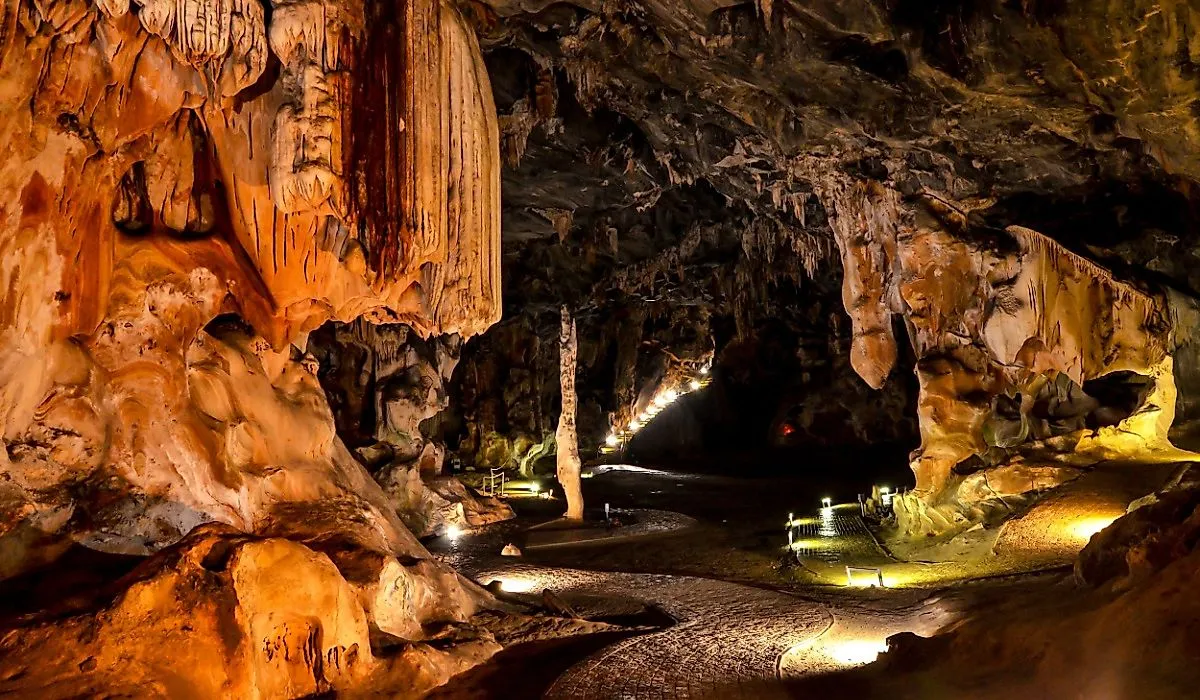Mammoth Cave, the longest known cave system on Earth, is a world of mystery, beauty, and ancient history that is concealed beneath the undulating hills of south-central Kentucky. With over 440 miles of explored passageways and still more being discovered each year, Mammoth Cave isn’t just a geological marvel—it’s a cultural, scientific, and ecological treasure trove that continues to captivate explorers, tourists, and scientists alike.
A Monumental Underground Labyrinth
What makes Mammoth Cave truly remarkable is its immense size. As of 2025, over 440 miles have been mapped, but geologists believe that could be just half of what lies below. Some areas are so remote and narrow that only the slimmest of cavers can explore them. This labyrinth of tunnels, caverns, and vertical shafts connects multiple levels of underground terrain, carved over millions of years by the steady flow of water through the limestone bedrock.
Despite its name, Mammoth Cave doesn’t contain fossils of mammoths. The term “mammoth” refers to the cave’s enormous scale, with chambers like Mammoth Dome and Grand Avenue that dwarf human visitors.

A Geological Time Capsule
Mammoth Cave is a product of the Pennyroyal Plateau’s karst topography, where soft limestone dissolves over time, creating sinkholes, underground rivers, and vast cave systems. The upper levels of the cave tend to be dry and dusty, while the lower levels are still shaped by the flowing waters of the Green River.
Walking through the cave is like stepping through geological time. The ceilings are lined with gypsum crystals, and the walls are etched with ancient water lines and sedimentary patterns. The cave’s formations—stalactites, stalagmites, flowstones, and gypsum flowers—are evidence of nature’s slow, patient artistry.
A Legacy of Human History
Long before tourists arrived with flashlights and walking shoes, Native Americans explored Mammoth Cave. Archaeological evidence, including torches, sandals, and mining tools, shows that indigenous peoples entered the cave over 5,000 years ago. They mined minerals like gypsum and mirabilite and may have even used the cave for ceremonial purposes.
In the 19th century, enslaved African Americans played a crucial role in the early exploration and mapping of the cave. One of the most notable figures was Stephen Bishop, a slave who became one of Mammoth Cave’s first guides. His hand-drawn map, created from memory, remained accurate for decades and is still honored as a historical document today.
A Scientific Goldmine
The cave is more than a tourist attraction—it’s a living laboratory. Scientists study its unique ecosystems, geology, and climate to learn about subterranean life and environmental changes.
Among the most fascinating discoveries are the troglobites—creatures that have adapted to complete darkness. These include:
- Blind cavefish
- Eyeless crayfish
- Transparent spiders
- Cave beetles and salamanders
Without sunlight, many of these species have evolved without eyes and developed heightened senses of smell and touch. Because the cave environment is so stable, it also provides important data for climate research, water quality studies, and biodiversity monitoring.

Related Blog: EU Drops Visa Rules for 7 Countries Starting July 2025
Mammoth Cave Today: A Modern National Park
Established as a national park in 1941, Mammoth Cave now spans over 52,000 acres of protected land. Above ground, the park features lush forests, rivers, hiking trails, and campgrounds, making it a year-round destination for nature lovers.
Inside the cave, guided tours range from short, accessible walks to adventurous crawls through tight passageways and unlit tunnels. Popular tours include:
- Historic Tour – A two-hour journey through vast chambers and tight squeezes that share the cave’s early history.
- Domes & Dripstones Tour – A deeper descent into areas with incredible stalactite and flowstone formations.
- Wild Cave Tour – A strenuous six-hour adventure for the brave and physically fit, complete with belly-crawling and rope climbs.
Safety is a top priority, and strict conservation efforts ensure that human activity doesn’t disturb the cave’s delicate environment.
The Role of Water and Climate
The Green River, which runs through the national park, is central to Mammoth Cave’s creation and evolution. Over thousands of years, the river and its tributaries have eroded the limestone, creating underground rivers, lakes, and shafts. Today, hydrologists continue to study these water systems to better understand the cave’s growth and the region’s aquifer health.
Additionally, Mammoth Cave plays a role in monitoring climate change. Because of its consistent year-round temperature of about 54°F, scientists can monitor long-term changes in biodiversity, water chemistry, and air quality with little disruption from seasonal variations.
Ghosts, Myths, and Cultural Impact
Like many ancient landmarks, Mammoth Cave is steeped in folklore and mystery. Some say the cave is haunted—visitors have reported unexplained noises, flickering lights, and eerie feelings deep in the tunnels.
There’s even a tuberculosis hospital history tied to the cave. A physician thought that TB sufferers may be cured by the cave’s steady climate in the 1800s. Several patients were housed in the cave for months, but unfortunately, the plan failed, and some died within its dark walls. Their stone huts remain as grim reminders of this tragic experiment.
Mammoth Cave has also inspired authors, poets, and artists. It has appeared in books, documentaries, and even video games, solidifying its place in American cultural consciousness.
Conservation Challenges and Efforts
Despite its protected status, Mammoth Cave faces several threats:
- Pollution from nearby agriculture and industry.
- Invasive species are affecting native plants and wildlife.
- Climate change is altering rainfall patterns and underground water flow.
- Human traffic is risking damage to fragile cave formations.
Park rangers and conservationists work tirelessly to preserve the cave’s health. Efforts include:
- Controlled tour group sizes.
- “Leave no trace” visitor policies.
- Ongoing scientific monitoring.
- Partnerships with local communities and universities.
How to Visit and What to Expect
Visiting Mammoth Cave is an unforgettable experience. The park offers:
- Guided cave tours (book in advance, especially during peak season).
- Hiking trails, including the Green River Bluffs Trail and Sinkhole Trail.
- Camping sites and nearby lodges for extended stays.
- Educational programs, ranger talks, and Junior Ranger activities for kids.
Accessibility is a priority, and some cave tours and surface trails are wheelchair-friendly. Visitors are also encouraged to follow decontamination protocols to prevent the spread of White-nose Syndrome, a deadly fungus affecting bat populations.
Conclusion: A World Beneath Our Feet
Mammoth Cave is more than just a hole in the ground—it’s a vast, living chronicle of Earth’s history, human ingenuity, and nature’s resilience. From ancient Native American explorers to modern scientists, from epic chambers to microscopic creatures, the cave continues to reveal new secrets with every passing year.
As the longest known cave system in the world, Mammoth Cave challenges us to look deeper—literally and metaphorically—into the ground beneath us and appreciate the intricate wonders hidden in the dark. For those who dare to explore, it offers awe, mystery, and a sense of timeless connection to the forces that shape our planet.




